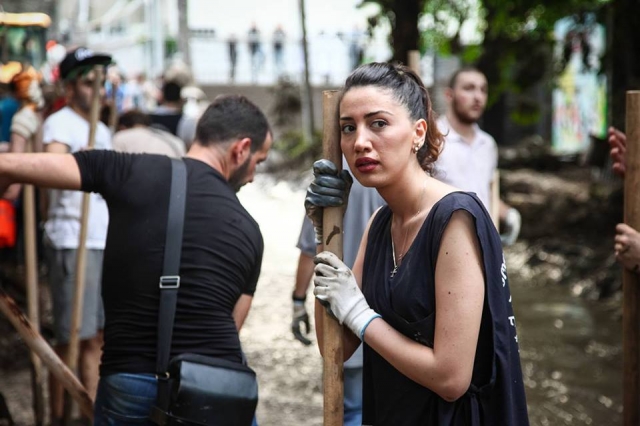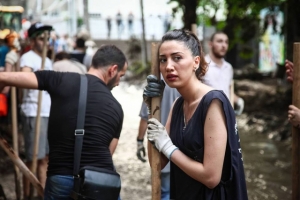The Story Behind the Picture
On the morning after devastating floods hit the Georgian capital, Giorgi Isakadze picked up his camera and headed straight for Heroes’ Square. It’s his job – as well as studying design at Tbilisi’s Academy of Arts, as Giorgi takes photos for the Ministry of Infrastructure and Regional Development. As one of the first photographers on Heroes’ Square that miserable Sunday morning, Giorgi’s lens captured a moment in the making.
Responding to a call for volunteers, hundreds of people from every walk of life – unconnected by anything other than a common purpose - threw themselves into the clean-up operation alongside the army, police force and fire and rescue services.
The pictures that Giorgi took of those first volunteers – literally mucking in – captured a moment that can never be forgotten by anyone who witnessed it. The ever-increasing crowd of volunteers – representing every cross-section of Tbilisi society – morphed into an unstoppable, unified force. Their gloves, face-masks and shovels became tokens of honour and pride, as they salvaged hope from the ruin around them.
Giorgi’s photos from that day were published in a widely-shared photo-essay on Facebook. They appeared (uncredited – much to his chagrin) on Georgian TV and on other websites. But one photo stood out from the rest.
“When I saw her, I just thought, how unusual it is to see this type of girl standing in mud” Giorgi told me, as I sifted through his photos for a feature I was writing on the aftermath of the floods. The editor had asked me for images of flood victims and their ruined houses, but I couldn’t get this picture out of my mind.
There was something about her expression – a combination of exhaustion, grief and determination – which I found utterly inspiring. Hers was the face of the volunteer movement as a whole – a generation of young people engaged in a spontaneous and inspiring civil action of a type scarcely seen in other post-Soviet states.
Giorgi posted the picture on his Facebook wall asking ‘does anyone know this girl?’ and within seconds, he was inundated with ‘pings’ linking him to various profiles. One of them belonged to Tako Chokheli.
“The first bad news I heard was about the destruction of the zoo” says Tako, after agreeing to meet with me and Giorgi over an ice cream the following day. “Since I love animals so much, this upset me a lot.”
“Later I heard that people had died and houses had been destroyed … When I heard that they were accepting volunteers I decided to go to Heroes’ Square with my friends.”
Tako studies International Relations at the Georgian Institute of Public Affairs and speaks about the aftermath of the floods with the forced precision of a news reader as she tells me about the day the photograph was taken.
“One incident which I would particularly like to draw attention to and which surprised me was the following,” she says. “When we arrived at the zoo, it was still covered in a thick layer of mud. Up to my knees in mud, my boots got stuck and I couldn’t move. A 40 or 50 year old man who was working alongside us came and rescued me, despite the fact that I was covered in dirt.”
We talk about how she thinks the city has been changed by this experience. Her response surprises me: “This notion we have of women as the ‘weaker sex’ totally disappeared on that day,” she says. “Not one single women or girl was working with less strength or determination than men or boys.”
I ask her if she likes the photo. “Of course. I like the way it’s very natural and yet meaningful. He took it just at the point when we’d finished cleaning up and I decided to rest for a bit … I think it pretty much sums up the way we all felt inside on that tragic day.”
Joseph Alexander Smith












